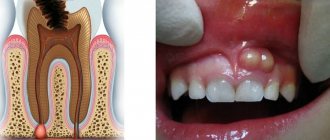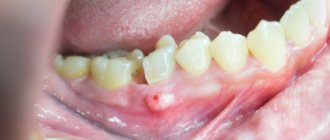A peritonsillar abscess is a purulent cavity located in the tissues at the level of the soft palate above the palatine tonsil. Most often, such purulent inflammation occurs against the background of a previous sore throat or exacerbation of chronic tonsillitis. A purulent lesion can be on the right or left in the pharynx, or it can be bilateral. Treatment of peritonsillar abscess is usually surgical. Conservative therapy is carried out at the initial stage of inflammation. A peritonsillar abscess often results in removal of the tonsils. The causes, symptoms and methods of treating abscess are the topic of our new article.
A peritonsillar abscess is a festering cavity. It is localized in the tissues, at the level of the soft palate above the palatine tonsil. These tissues are called paratonsillar tissue. The concept of “peritonsillar abscess” is already a purulent process. It is preceded by diagnoses such as paratonsillitis and phlegmonous tonsillitis. All three of these diagnoses describe the progression of one condition into another, more severe one.
The disease is the highest degree of inflammation of the tonsils and one of the most severe forms of purulent lesions of the pharynx. One third of cases of paratonsillitis development occur as complications of the disease “chronic tonsillitis”. Also, phlegmon can form in the mediastinum - the diagnosis sounds like mediastinitis. This can happen if treatment for the disease is ignored.
Most often, this diagnosis is made at a young age - up to thirty - thirty-five years.
Inflammation can occur in several forms depending on its location. It can also be unilateral (with a lesion on the left we are talking about a left-sided paratonsillar abscess, with a lesion on the right - about a right-sided paratonsillar abscess), less often - bilateral.
Treatment of a left-sided throat abscess, as well as treatment of a right-sided abscess, should be carried out only under the supervision of an otolaryngologist. Attempts to treat the disease at home are not only ineffective, but also dangerous, as they can provoke serious complications of the disease.
The causes, signs, symptoms and treatment of peritonsillar abscess are the topics of our new article.
How to treat peritonsillar abscess?
Treatment is carried out in two stages:
- Surgical.
- Conservative.
First of all, it is necessary to evacuate the pus from the peritonsillar space.
This can be done in the following ways:
A) Tonsillectomy - removal of the tonsils.
B) Puncture (puncture) and aspiration.
B) Opening (incision) and dividing the paratonsillar space.
After draining the pus, the patient should receive antibacterial and anti-inflammatory therapy.
More about the disease
Peritonsillitis is an acute condition secondary to tonsillitis or tonsillopharyngitis, which results in the penetration of an infectious agent (bacteria) into the loose peritonsillar tissue (peritonsillar space). The process is always one-sided, as a result of which it has certain symptoms:
- pain or increased pain on one side;
- severe difficulty swallowing;
- swelling and bulging on the neck on one side;
- asymmetry and bulging of pharynx tissues.
A peritonsillar abscess occurs when a cavity filled with pus forms, located in the peritonsillar (peritonsillar) tissues.
It can form several days after the development of a sore throat or an exacerbation of tonsillitis. Less commonly, due to traumatic injury to the oropharynx or penetration of a foreign body into the tissue around the tonsils. In people with a weak immune system, an abscess can form within a day. It is more often unilateral, but cases with bilateral paratonsillar abscess have been reported in the literature. This pathology is one of the most severe purulent lesions of the oropharynx. With further spread, the infection moves into the deep tissues of the neck (parapharyngeal space), which can lead to a life-threatening condition. Depending on their location, there are several forms of peritonsillar abscess, but all of them require surgical treatment.
The Surgical Otolaryngology Center at GMS Hospital provides proper treatment and diagnosis of paratonsilitis and paratonsillar abscess of any form. Treatment tactics are selected by specialists individually, depending on the stage of the disease, the presence of complications and concomitant pathologies.
Methods for identifying and treating pathology
Considering that an abscess, especially at the abscess stage, has characteristic manifestations, the doctor usually does not have any problems making a preliminary diagnosis.
After examining and collecting anamnesis, the doctor will refer the patient for pharyngoscopy and some tests - a general analysis and blood biochemistry, a smear for bacterial culture and a diphtheria pathogen from the pharynx.
To determine the depth of the lesion, ultrasound and computed tomography of the neck may additionally be prescribed. It is important to differentiate the disease from other lesions - scarlet fever, diphtheria, carotid artery aneurysm.
Treatment of paratonsillitis includes drug therapy and surgery - opening of the paratonsillar abscess.
Antibiotics are mandatory prescribed as etiotropic therapy. In addition, the patient must be prescribed antipyretic, anti-inflammatory and painkillers. To have a local effect on the inflammatory process, you need to rinse the mouth and throat with antiseptic solutions.
Surgery is the most effective method of eliminating an abscess. It can be performed on patients according to indications, regardless of gender and age.
Diagnostics
Upon external examination of the patient, slight asymmetry of the neck and possible swelling and redness of the skin may be noted. The appearance of these symptoms depends on the location of the pathological focus.
Palpation can reveal enlarged regional lymph nodes on the affected side, as well as fluctuations in the superficial location of the abscess.
Endoscopically, swelling of the laryngeal mucosa and the presence of a yellowish infiltrate against the background of hyperemia of the surrounding tissues are detected. As the process progresses, the formation of norites can be observed.
Pus can break into the trachea and lower respiratory tract and cause an inflammatory process to develop there.
The presence of a purulent-septic condition is also indicated by the results of laboratory blood tests. In the general blood test, leukocytosis, increased ESR, and a shift in the leukocyte formula to the left are observed.
A biochemical blood test reveals a slight decrease in total protein, dysproteinemia, and acid-base imbalance.
Treatment
The goal of treatment of this disease is the elimination (emptying and sanitation) of the purulent focus of inflammation.
At the infiltration stage, anti-inflammatory and antibacterial drugs are prescribed. The patient's breathing should be carefully monitored, and in the event of acute laryngeal stenosis (narrowing of the airways), a tracheotomy operation is necessary, and in extreme cases, when minutes count, a conicotomy, followed by a tracheostomy operation. If an abscess has already formed, then it needs to be drained. After surgery to open a laryngeal abscess, inhalation with antibiotics is prescribed. In this case, the drug Bioparox has a good effect, which must be used topically for 7-10 days.
Make an appointment right now!
Call us by phone or use the feedback form
Sign up
Rehabilitation
The recovery process takes 1-2 weeks. You can eat almost immediately, but the food must be liquid. For several days after the procedure of opening the abscess, the wound will hurt while swallowing food.
After the operation, you should adhere to the following rules:
- do not warm your neck;
- do not drink very hot or cold drinks;
- the menu should include liquid food without acid and spices (they will irritate the wound);
- exclude alcohol, preferably not smoke;
- avoid hypothermia;
- take medications prescribed by your doctor (vitamins, antibiotics).
It is important to sanitize all possible foci of infections in the oral cavity and nasopharynx. It is necessary to remove caries, treat chronic throat diseases and strengthen the immune system.
Causes and course of the disease
Most often, the cause of a laryngeal abscess is damage to the mucous membrane of the hypopharynx by some foreign object, for example, a fish bone, during the passage of a food bolus through the hypopharynx into the esophagus.
Purulent inflammation mainly occurs in the area of one of the arytenoid cartilages or the lingual surface of the epiglottis. As a rule, a laryngeal abscess develops gradually and is accompanied by a general inflammatory reaction of the entire body: increased body temperature, weakness, adynamia, inflammatory changes in the blood, etc. Due to prolonged inflammation, a cavity is formed - a pocket in which pus accumulates. At the same time, visually the place where the most significant bulging is observed is the place where pus accumulates. The contents of the purulent pocket are often visible through the mucous membrane, and it looks like a kind of yellowish spot.
Clinical picture
The general condition of the patients has deteriorated significantly; there is a high temperature (39-40ºС), severe chills, lethargy, and loss of appetite.
Due to the presence of a formation in the laryngeal cavity that disrupts the free passage of air and compresses adjacent tissues, patients complain of:
- feeling of constriction when swallowing;
- sensation of a foreign body in the throat;
- choking on food;
- difficulty breathing;
- hoarseness of voice;
- change in voice timbre;
- feeling of fullness in the throat;
- cough.
However, what worries patients most is a strong sensation of pain in the larynx, which can radiate to the ear, temporal region or back of the head.
Sometimes the pain can be so unbearable that there is a threat of painful shock. The peculiarity of the course of this disease, in comparison with other pathologies of the larynx, is that it develops at lightning speed.
Over the course of several hours, the size of the infiltrate and swelling of the surrounding tissues can reach such a level that it threatens the development of suffocation.
Technique
Opening a paratonsillar abscess surgically occurs in a hospital setting or on an outpatient basis. The following categories of patients are recommended to go to the clinic:
- children;
- elderly people;
- patients with relapses of the disease;
- pregnant women.
Progress of the operation:
- Before performing surgical procedures, anesthesia is performed with a solution of Lidocaine, Ultracaine. The affected area is treated with an anesthetic from a nebulizer. Sometimes general anesthesia is used. In rare cases, when it is enough to just touch the abscess with a scalpel to empty it, anesthesia is not used.
- The location of the opening is outlined - this is the area with maximum swelling or the greatest bulging in the area of the palatal arch. If there is no visual reference, then the incision will be made in a place where spontaneous opening often occurs. Here there is the least likelihood of injury to blood vessels.
- The surgeon makes a cut with a scalpel in the sagittal plane with a depth of 1.5-2 cm and a length of 2-3 cm.
- A Hartmann syringe is inserted into the incision, with the help of which the hole is expanded to 4 cm. In this case, possible bridges in the abscess cavity are destroyed.
- The pus is sucked out using an electric device. Sometimes preliminary aspiration with a syringe before the incision is practiced.
- The abscess cavity is washed with an antiseptic.
- If necessary, drainage is installed to drain pus.
The operation is quite uncomfortable, so you should entrust it to a qualified doctor who will make a minimal incision.
It happens that after opening the edges of the cavity stick together, and a pathological process may begin. In this case, you need to push them apart again using Hartmann's forceps. In case of complex localization of the abscess, recurrent tonsillitis and abscesses, tonsillectomy (complete removal of the tonsils) is indicated.
The technique for opening a paratonsillar and retropharyngeal abscess is practically the same.
Classification
There are the following types of throat abscess:
- Peritonsillar abscess - purulent inflammation occurs in the tissue of the tonsils;
- Retropharyngeal abscess - more common in adults, affects the tissue around the retropharyngeal lymph node;
- Periopharyngeal abscess - inflammation forms in the peripharyngeal part of the throat.
Classification according to abscess location:
- Anterior abscess - forms in the upper part of the tonsils;
- Posterior abscess – formed between the palatine arch and the tonsils;
- Lower abscess - a type that is difficult to diagnose and treat, is located under the palatine tonsil;
- Lateral abscess is difficult, with complications, and forms on the side of the tonsil.
Types of retropharyngeal abscess according to its location:
- Epipharyngeal – formed above the velum;
- Mesopharyngeal - formed between the edge of the velum and the root of the tongue;
- Hypopharyngeal – formed below the root of the tongue;
- Mixed – occupies 2-3 zones at the same time.
Preparing for surgery
Surgery is performed only when the abscess is “ripe,” that is, a purulent pocket is completely formed. This usually occurs on the 5th day after tonsil swelling occurs.
Checking the readiness of the cavity for opening is carried out by a diagnostic puncture. Using a large needle, a puncture is made in the place that sticks out the most. All manipulations are controlled by an ultrasound machine or endoscopic observation. If pus is detected in the sample, it means that the abscess is ripe for surgery.
If necessary, a blood test is prescribed, as well as a culture to determine the pathogen and check for resistance to antibacterial drugs.
After the examination, the patient is sent to the operating room, where the abscess will be surgically opened.











